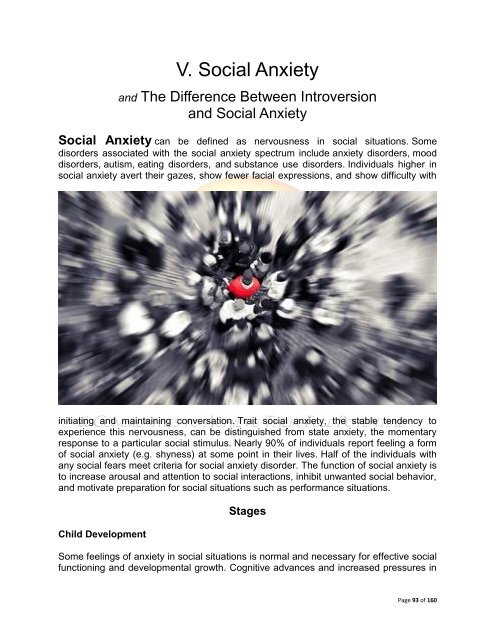The Gift of Introversion
The Gift of Introversion
The Gift of Introversion
You also want an ePaper? Increase the reach of your titles
YUMPU automatically turns print PDFs into web optimized ePapers that Google loves.
V. Social Anxiety<br />
and <strong>The</strong> Difference Between <strong>Introversion</strong><br />
and Social Anxiety<br />
Social Anxiety can be defined as nervousness in social situations. Some<br />
disorders associated with the social anxiety spectrum include anxiety disorders, mood<br />
disorders, autism, eating disorders, and substance use disorders. Individuals higher in<br />
social anxiety avert their gazes, show fewer facial expressions, and show difficulty with<br />
initiating and maintaining conversation. Trait social anxiety, the stable tendency to<br />
experience this nervousness, can be distinguished from state anxiety, the momentary<br />
response to a particular social stimulus. Nearly 90% <strong>of</strong> individuals report feeling a form<br />
<strong>of</strong> social anxiety (e.g. shyness) at some point in their lives. Half <strong>of</strong> the individuals with<br />
any social fears meet criteria for social anxiety disorder. <strong>The</strong> function <strong>of</strong> social anxiety is<br />
to increase arousal and attention to social interactions, inhibit unwanted social behavior,<br />
and motivate preparation for social situations such as performance situations.<br />
Child Development<br />
Stages<br />
Some feelings <strong>of</strong> anxiety in social situations is normal and necessary for effective social<br />
functioning and developmental growth. Cognitive advances and increased pressures in<br />
Page 93 <strong>of</strong> 160

















